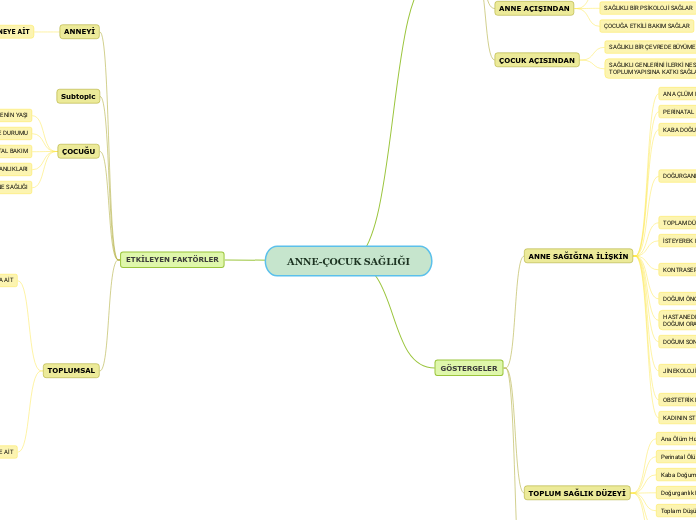by rabia kumtepe 4 years ago
211
ANNE-ÇOCUK SAĞLIĞI
Anne ve çocuk sağlığı, toplum sağlığının temel taşlarından biridir. Bu alanda doğurganlık hızları, bebek ve çocuk ölüm oranları, perinatal ve neonatal dönemler gibi göstergeler önem taşır.

by rabia kumtepe 4 years ago
211

More like this
Tenses demonstrate the time of actions centered around the subject of the sentence. These actions are called verbs and change according to tenses.
There are four Future tenses:
Future Perfect Simple is used for:
Adverb used with Future Continuous:
Structure:
Will + Subject + Have + Past Participle?
e.g. Will you have met your colleague by this time tomorrow?
ÜLKENİN GELİŞMİŞLİK DÜZEYİ
COĞRAFİ KONUM
KADININ TOPLUMDAKİ STATÜSÜ
TOPLUMUN GENEL HABERLEŞME VE ULAŞIM DÜZEYİ
TOPLUMUN GENEL BESLENME DÜZEYİ
LOHUSALIK DÖNEMİ BAKIM HİZMETLERİ
NÜFUS POLİTİKASI
SAĞLIK SİSTEMİ
GENEL SAĞLIK DÜZEYİ
Type in your own examples or you can also choose from the examples below.
Form of word "to be":
Form of word "to have":
Structure:
Subject + Won’t Have + Past Participle
e.g. I won’t have met my friend form United States by this time tomorrow.
YOKSULLUK
ÇEVRESEL KİRLİLİK
ATIKLAR
AİLE HİJYENİ
BULUNDUĞU COĞRAFİ KONUM
DİNİ UYGULAMALAR
KÜLTÜR
ÇEVRE VE SOSYAL DESTEK
SOSYOEKONOMİK DURUM
Type in your own examples or you can also choose from the examples below.
Form of word "to be":
Form of word "to have":
Future Continuous is used:
Adverb used with Future Continuous:
Structure:
Will + Subject + Be +Verb-ING?
e.g. Will you be having fun at the party?
Structure:
Subject + Won’t Be + Verb-ING
e.g. He won’t be having fun at the party.
Structure:
Subject + Will Be + Verb-ING
e.g. You will be having fun at the party.
Future Simple is used:
Future Simple with 'will'' is used:
Some adverbs used with Future Simple:
ALIŞKANLIKLARI
GENETİK RAHATSIZLIK
SİSTEMİK HASTALIK
GEBELİK ARALIĞI
DOĞUM SAYISI
Structure:
Subject + Won’t (will not) + V1(First Form of Verb)
e.g. You won’t see Mary when she comes back from Denmark.
YAŞ
Structure:
Subject + Will + V1(First Form of Verb)
e.g. I will see Mary when she comes back from Denmark.
There are four Past tenses:
Past Perfect Simple is used for:
The Past Perfect tense is not normally used alone. It is used to denote the earlier of two past actions. We use Past Simple for the latter action.
Some adverbs used with Past Perfect Simple:
Structure:
Subject + had + Past Participle
e.g. They had already met Julia before the party.
BEBEK VE 5 YAŞ ALTI
NEONATAL
POSTNATAL
PERİNATAL
Type in your own examples or you can also choose from the examples below.
Form of verb 'to be':
Form of verb 'to have':
Past Continuous is used for:
Some adverbs used with Past Continuous:
Structure:
Was/ were + Verb-ING?
e.g. Were you studying when she called?
Structure:
Subject + wasn’t (was not)/ weren’t (were not) + Verb-ING
e.g. You were not studying when she called.
Structure:
Subject + was/ were + Verb-ING
e.g. You were studying when she called.
Past simple expresses:
Some adverbs used with Past Simple:
İNFERTİLİTE ORANI
CYBH
GELENEKSEL(ETKİSİZ)
MODERN (ETKİLİ)
TAMAMLANMAMIŞ
TOPLAM
YAŞA ÖZEL
GENEL
Structure:
Did + subject + Base Form of the Verb?
e.g. Where did you meet her?
Structure:
Subject + did not/didn’t + Base Form of the Verb
e.g. They didn’t like my food.
Structure:
Subject + Verb in Past Simple (2nd form)
e.g. They lived in Spain three years ago.
There are four Present tenses:
Present Perfect Continuous is used:
Some adverbs used with Present Perfect Continuous:
Structure:
Subject + haven’t/hasn’t been + Verb-ING
e.g. She hasn’t been playing tennis for a long time.
Structure:
Subject + have/ has been + Verb-ING
e.g. They have been learning French for two years.
Present Perfect is used for:
Some adverbs used with Present Perfect:
Structure:
Have/ has +Subject+ Past Participle?
e.g. Has she finished the letter?
Structure:
Subject + haven’t (have not)/ hasn’t (has not) + Past Participle
e.g. She hasn’t finished the letter.
Structure:
Subject + have/ has + Past Participle (3rd Form of the Verb)
e.g. She has finished the letter.
Present Continuous is used to indicate the ongoing time (now).
Some adverbs used with Present Continuous:
Structure:
BE + Subject + Verb-ING?
Are you eating now?
Structure:
Subject + BE not + Verb-ING
e.g. You are not eating now.
Structure:
Subject + BE (am/is/are) + Verb-ING
e.g. You are eating now.